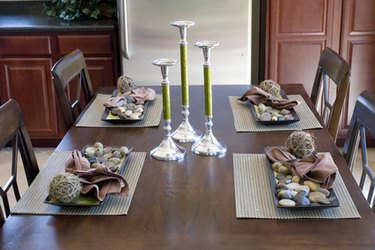Things You'll Need
Hammer
Nails
Marbles in a sock
Two contrasting paint colors
Rough sandpaper
Paintbrush
Paint trays
Flat off-white latex paint
Cloth
Paint scraper
Pint of glaze
Pigment
Steel wool

Wainscoting, a decorative wood treatment covering the lower portion of a wall, has been a staple in homes since the 1600s. Although it serves no structural purpose, it was originally used to hide moisture that had seeped up from the ground and rotted walls in the home. Today's wainscoting is more decorative in nature. You can use trim pieces to create elegantly patterned boxes on the walls, or you can employ beadboard to add a sense of history and style to a room. You can distress the wood to create an antiqued look that belies your home's true age
Distress and Paint the Wood
Step 1
Distress the wainscoting by using a hammer, nails, marbles in a sock or other implements to create nicks and dings on the surface of the wood.
Video of the Day
Step 2
Paint the wood with a basecoat of your chosen color, such as white. Let dry completely.
Step 3
Apply a second coat of paint in a contrasting color, such as black. Let this coat dry completely.
Step 4
Use sandpaper to remove the second coat of color at the edges and corners, where natural wear would happen. The basecoat will show through, giving a naturally aged look to your wainscoting.
Distress and Stain the Wood
Step 1
Distress the wainscoting by using a hammer, nails, marbles in a sock or other implements to create nicks and dings on the surface of the wood.
Step 2
Apply a coat of flat latex in an off-white shade. Use a cloth rag instead of a brush to create an uneven film of color. Let the paint dry.
Step 3
Scrape off parts of the paint using a paint scraper and sandpaper.
Step 4
Add a tablespoon of the off-white latex to a pint of glaze. Add a pigment, such as yellow ocher or raw umber, to add depth and dimension to the glaze. Apply glaze to the wainscoting with a paintbrush.
Step 5
After 10 minutes, rub down the glaze with steel wool. This step will remove the glaze from the high surfaces but leave it in the crevices and nicks that you've created in Step 1.
Video of the Day